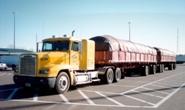Shipping and Logistics

April 2017 Logistics Report
Written by Sandy Williams
April 16, 2017
Freight shipment on the seas, rivers, rails and by truck moved without many complications in the past few weeks. The seaborne freight market spot rates are recovering and foreign steel industries are boosting cargos of coal and iron ore. Spot rates have caught up with demand for the trucking industry and rail traffic was up.
Seaborne Freight
The seaborne freight market is firming up again according to the most recent MID-SHIP Report. MID-SHIP expects the dry bulk market to continue a slow upward trajectory with some volatility.
Spot market rates fell in February but have since recovered. An improving global economic market, particularly the steel market in China, India and Europe, and the resulting increased demand for coal and iron ore has bolstered shipping. Disruptions to the Australian coal market following the recent cyclone has the US east coast booked through second quarter for coal and petcoke export demand, said MID-SHIP. Geopolitical concerns and new vessel delivery may affect the shipping market in the coming months.
The Baltic Dry Index closed at 1,282 on April 17, climbing sharply in the past week. The BDI tracks dry-bulk rates based on vessel size and shipping route and is a used as a benchmark for overall trade volume.
Barge
Rivers in the U.S. continue to experience high waters causing complications for river navigation in some areas. Lock maintenance will continue throughout the summer causing delays in some areas. MID-SHIP reports inclement weather on the Lower Mississippi River has slowed loading and discharging resulting in some congestion and berthing delays.
U.S. Ports
US ports are forming alliances to improve operations and revenue. Seattle and Taocama consolidated and launched the Northwest Seaport Alliance last year and U.S. maritime regulators cleared the way earlier this month for an alliance between the Georgia and Virginia port authorities. Under the East Coast Gateway Port Terminal Agreement, The Virginia and Savannah ports will share information on operations, jointly acquire operating systems and equipment and draft agreements with carriers, shippers and terminal operators. Marketing efforts will be coordinated. The ports may not, however, “jointly negotiate, set and approve terminal rates or charges” said the Federal Maritime Commission.
Trucking
DAT Trendlines reports spot market rates have finally caught up to freight volumes. Flatbed freight volume was strong in March with rates improving near the close of the month. During the week April 2-8, flatbed spot rates rose 2.0 percent from the previous week and were up 3.6 percent in March compared to February. Spot rates ranged from $1.77 per mile in the Phoenix area to $3.29 per mile in the Northeast. National average fuel price increased 2 cents to $2.58 per gallon during the week.
Demand was high for flatbed trucks during the week ending April 8 but with loads posts increasing less than 1 percent and truck posts up 4 percent, the load-to-truck ration declined 4 percent to 39.1 loads per truck.
The American Truck Association For-Hire Truck Tonnage Index lost 1 percent in March after inching down 0.1 percent in February.
“Like several other economic indicators, March truck tonnage was likely hurt by some late season winter storms,” said ATA Chief Economist Bob Costello. “Despite last month’s dip, seasonally adjusted tonnage rose 1.2% during the first quarter overall from the previous quarter, and increased 0.2% from the same quarter last year.
“While I’m not expecting a surge in truck tonnage anytime soon, the signs remain mostly positive for freight, including lower inventory levels, better manufacturing activity, solid housing starts and good consumer spending,” he said. “As a result, we can expect moderate growth going forward.”
Railroad
The Association of American Railroads reported U.S. rail traffic for the week ending April 8, 2017 was up 7.1 percent to 513,022 carloads and intermodal units compared to the same week last year. Total carloads for period were 252,056 carloads, up 9.8 percent compared with the same week in 2016, while U.S. weekly intermodal volume was 260,966 containers and trailers, up 4.6 percent compared to 2016.
The AAR expressed its concern at the end of March regarding potential trade policies that would curtail trade and threaten U.S. freight rail jobs. Restrictions on imports and exports would affect industry jobs and revenue for truck carriers that move products across our neighboring borders as well as to ports for international export.
“For a highly capital-intensive industry that has spent $26 billion annually in recent years, private investment is the lifeblood of a freight rail sector that must devote massive sums to safely, efficiently and affordably deliver goods across the economy,” said said AAR President and CEO Edward R. Hamberger. “Upending the ability of railroads to do so by undermining free trade agreements that have done far more good than harm would have far reaching effects.”

Sandy Williams
Read more from Sandy WilliamsLatest in Shipping and Logistics

US Great Lakes iron ore cargoes down notably through May
The Lake Carriers' Association reported a considerable decline in monthly iron ore shipments from US ports on the Great Lakes.

Wittbecker: West Coast port congestion
What's going on in West Coast ports?

Wittbecker: Mexico invests in port capacity despite US tariff troubles
The Mexican government aims to transform Manzanillo into the largest seaport in Latin America, capable of processing some 10 million TEU (20-foot equivalent units) per year by 2030. It is already Mexico's largest port and the third largest in Latin America, handling nearly 4 million 20-foot containers in 2024.

Wittbecker on Aluminum: When do the tariffs reach Main Street?
Containers sailing from China in April are down 15%-20% and Hapag Lloyd says their future bookings transpacific are down 30%.

Wittbecker on Aluminum: US-China trade war clobbers cross-Pacific trade
Container shipping lines have sharply increased blank sailings on Transpacific routes in response to escalating trade tensions between the US and China.
